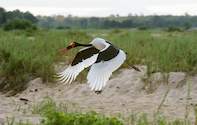
The contributions received from the public so far have been very encouraging with over 350 submissions and almost 2 000 photographs submitted.
Many of these photographs were useful for unique identification, and all aided in establishing distribution for the species while also providing some very interesting information on saddle-billed stork diet and habits.
Photographs showed saddle-billed storks eating a small crocodile and another eating a large snake that tied itself into a knot first. Various submissions of juvenile storks show that the birds are breeding successfully.
"The public has also assisted us in locating nest sites and should continue to do so as the breeding season has started and will continue throughout autumn," says Marcelle van der Hoven, project co-ordinator. A special saddle-billed stork aerial survey is planned during the winter months to locate more nest sites.
According to van der Hoven, it is too early in the survey to make any comments on current saddle-billed stork numbers, but visitors to the Park, especially to the northern regions, are encouraged to keep on submitting their photographs to storks@ewt.org.za.
"There are nice prizes up for grabs for the winning photographs and all photographers are making a very valuable contribution to the conservation of these birds." Look out for the project's posters and flyers, which have become a familiar sight at entrance gates, reception areas and rest rooms throughout Kruger.

 The saddle-billed stork photographic survey that took place in the Kruger National Park (KNP) from September 2009 to September 2010 has been...
The saddle-billed stork photographic survey that took place in the Kruger National Park (KNP) from September 2009 to September 2010 has been...